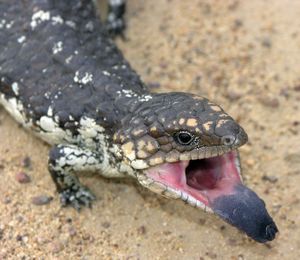Lizard Gastrointestinal System
| This article has been peer reviewed but is awaiting expert review. If you would like to help with this, please see more information about expert reviewing. |
Mouth
Lips
Lizards have moveable lips composed of flexible skin.
Teeth
Lizard teeth are used for grasping, piercing and breaking food or, in the case of monitors, slicing and cutting. Mollusk-eating Caiman lizards (Dracaena guianensis) and adult Nile monitors (Varanus niloticus) have broad rounded cheek teeth for crushing shells.
The teeth are generally pleurodont (attached to the sides of the mandible without sockets) but in some families, such as agamids (Agamidae) and chameleons (Chamaeleonidae), they are acrodont (attached to the biting edges of the jaws without sockets). The teeth of the venomous Gila monster and the Mexican beaded lizard are grooved to allow the flow of venom; however they have no direct connection to the sublingual venom glands. Venom is injected with the chewing action as it flows along the dental grooves.
Pleurodont teeth are shed and replaced whereas acrodont teeth are only replaced in very young specimens. For agamids and chameleons, special care should be taken to avoid damaging the acrodont teeth when opening a lizard's mouth with a rigid speculum as these teeth are irreplaceable. Furthermore, acrodont dentition is reportedly susceptible to periodontal disease.
Tongue
The tongue is generally mobile and protrusible. In the green iguana, the tip is darker than the rest and could be mistaken for a lesion. Lizards such as monitors and tegus have deeply forked tongues and chameleons have a projectile tongue for gathering food.
Gastrointestinal Tract
The organs and divisions of the gastrointestinal tract are similar to those of mammals. The lizard has a simple, J-shaped, elongated stomach. A caecum is present in many species. The large intestine is thin-walled and less muscular than the stomach or small intestines.
Herbivorous lizards such as the green iguana, prehensile-tailed skink, egyptian spiny-tailed lizard and chuckwalla (Sauromalus obesus) have a sacculated colon to facilitate hindgut fermentation. These animals usually have higher optimal body temperature zones in order to enhance microbial fermentation.
For information on lizard digestion, see here.
Cloaca
A cloaca is present (with a transverse cloacal slit) and is divided into three parts:
- coprodeum (collects faeces)
- ureodeum (collects urinary wastage)
- proctodeum (final chamber prior to elimination)
Literature Search
Use these links to find recent scientific publications via CAB Abstracts (log in required unless accessing from a subscribing organisation).
Gastroenterology of lizards: from anatomy to clinical medicine. Mitchell, M. A.; The North American Veterinary Conference, Gainesville, USA, Small animal and exotics. Proceedings of the North American Veterinary Conference, Volume 21, Orlando, Florida, USA, 2007, 2007, pp 1595-1597 - Full Text Article
References
- Mader, D.R. (2005). Reptile Medicine and Surgery. Saunders. pp. 1264. ISBN 072169327X

